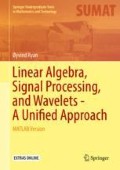Abstract
We saw in the previous chapter that the wavelet kernels G and H had some repeating structure in the rows and columns, similar to the circular Toeplitz structure in filters. Clearly the matrices are not filters, however. Nevertheless, we will now prove that wavelet kernels can be implemented easily in terms of filters. but that several filters are needed in the computation. Each of these filters will have an interpretation in terms of how the wavelet transform treats different frequencies. Much has been done in establishing efficient implementations of filters, and by expressing a wavelet transform in terms of filters we can take advantage of this.
Access this chapter
Tax calculation will be finalised at checkout
Purchases are for personal use only
Notes
- 1.
The name windowing is a bit strange. Here this does not correspond to applying a window to the sound samples as we explained in Exercise 3.9. We will see that it rather corresponds to applying a filter coefficient to a sound sample.
- 2.
It seems strange to use the name matrixing, for something which obviously is matrix multiplication. The reason must be that the procedure has been established outside a linear algebra framework.
References
T. Barnwell, An experimental study of sub-band coder design incorporating recursive quadrature filters and optimum ADPCM, in Acoustics, Speech, and Signal Processing, IEEE International Conference on ICASSP, pp. 808–811 (1981)
A. Cohen, I. Daubechies, J.-C. Feauveau, Biorthogonal bases of compactly supported wavelets. Commun. Pure Appl. Math. 45(5), 485–560 (1992)
A. Croisier, D. Esteban, C. Galand, Perfect channel splitting by use of interpolation/decimation/tree decomposition techniques, in International Conference on Information Sciences and Systems, pp. 443–446 (1976)
T.D. Lookabaugh, M.G. Perkins, Application of the Princen-Bradley filter bank to speech and image compression. IEEE Trans. Acoust. Speech Signal Process. 38(11), 1914–1926 (1990)
D. Pan, A tutorial on MPEG/audio compression. IEEE Multimedia 2, 60–74 (1995)
T.A. Ramstad, S.O. Aase, J.H. Husøy, Subband Compression of Images: Principles and Examples, vol. 6 (Elsevier, Amsterdam, 1995)
J.H. Rothweiler, Polyphase quadrature filters – a new subband coding technique, in ICASSP 83, Boston, pp. 1280–1283 (1983)
M.J.T. Smith, T.P. Barnwell, A new filter bank theory for time-frequency representation. IEEE Trans. Acoust. Speech Signal Process. 35(3), 314–327 (1987)
M. Vetterli, J. Kovacevic, Wavelets and Subband Coding (Prentice Hall, Upper Saddler River, 1995)
Author information
Authors and Affiliations
Rights and permissions
Copyright information
© 2019 Springer Nature Switzerland AG
About this chapter
Cite this chapter
Ryan, Ø. (2019). The Filter Representation of Wavelets. In: Linear Algebra, Signal Processing, and Wavelets - A Unified Approach. Springer Undergraduate Texts in Mathematics and Technology. Springer, Cham. https://doi.org/10.1007/978-3-030-01812-2_5
Download citation
DOI: https://doi.org/10.1007/978-3-030-01812-2_5
Published:
Publisher Name: Springer, Cham
Print ISBN: 978-3-030-01811-5
Online ISBN: 978-3-030-01812-2
eBook Packages: Mathematics and StatisticsMathematics and Statistics (R0)

